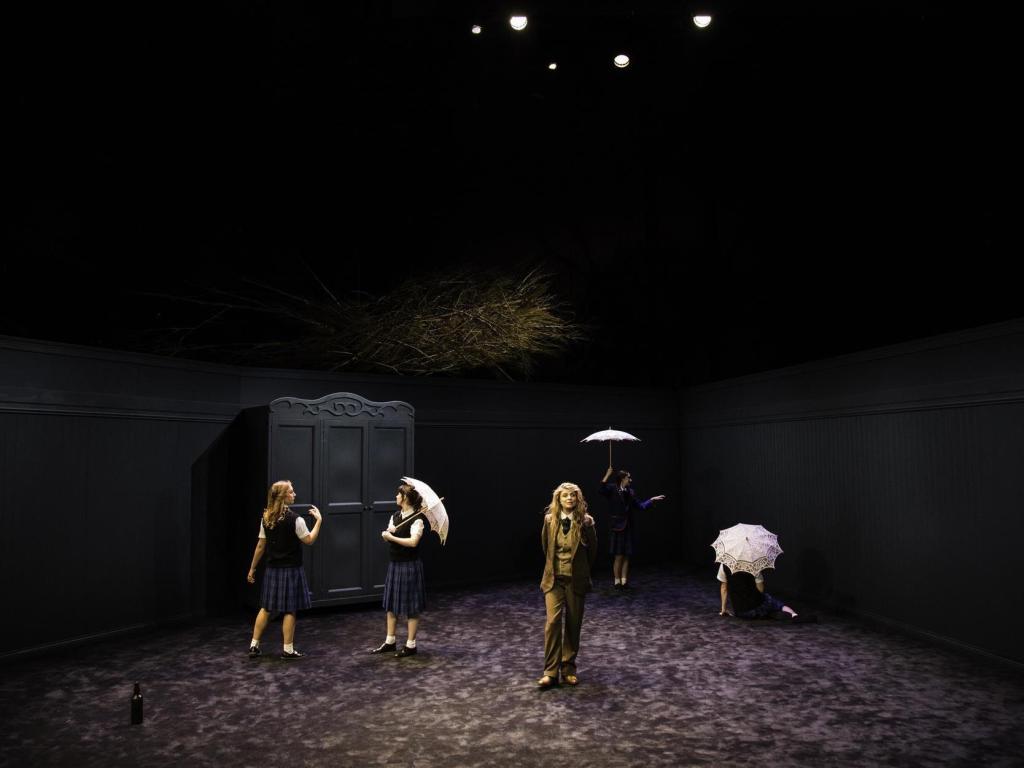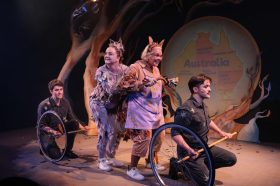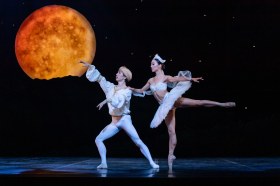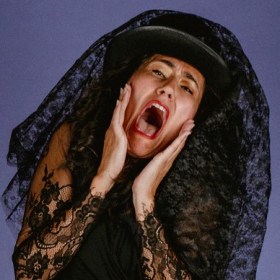Photo: Pia Johnson.
Malthouse Theatre and Black Swan Theatre Company’s co-production Picnic At Hanging Rock has been much anticipated by Melbourne theatregoers. Those who have seen Peter Weir’s film of the same name or read Joan Lindsay’s original novel will understand why. Picnic At Hanging Rock is a chilling and mesmerising tale, whose spooky series of events and ambiguous ending have kept audiences intrigued for decades.
The acting in this adaptation is superb, and the cast expertly guides its audience into a lingering sense of unease and dread, yet there is something amiss in the execution of this piece.
Much of the draw of the original novel and film adaptation is in the depiction of nature – the wild Australian bush landscape – as all consuming and an entity in itself. In this production, Zoë Atkinson’s set design does little to impress upon the audience the all-pervasiveness of the bush; instead, an oversized wardrobe dominates a stark foreground, the significance and utility of which is unclear. A nod to the indecipherable and the otherworldly, The Lion, The Witch, and the Wardrobe-style, perhaps? An immense collection of branches suspended above the set serves as the sole visual reminder that a large chunk of the action takes place in the natural environment.
While Peter Weir’s film juxtaposes the wildness of the bush with the delicate lace of 1900s picnic gowns in scenes that have remained in this viewer’s mind for more than 20 years, Director Matthew Lutton’s version imposes modern style school uniforms and a non-descript schoolroom setting, creating an unsatisfactory and jarring effect. The lack of visual reference to the landscape that is such an integral aspect of this work is disappointing and seems an obvious oversight.
The script, however, works hard to right this balance with incredibly detailed descriptions of the plot and natural environment spoken by the five female cast members. The women switch seamlessly between dialogue and narration, often changing characters three or four times within a scene. Special mention must go to Elizabeth Nabben for her skilful portrayal of schoolmarm Mrs Appleyard and to Amber McMahon, for her ethereal stage presence and easy inhabitation of English gentleman Michael FitzHubert. Arielle Gray, Harriet Gordon-Anderson and Nikki Shiels can also be congratulated on their energetic and magnetising performances.
Paul Jackson’s lighting design is phenomenal. The slow reveal of the aforementioned large branch structure helps set the play’s eerie tone from the start. A multitude of blackouts allows for some surprising and at times horrifying scene reveals. Props to the stage management team, which manages to execute some swift and impressive set changes while the entire auditorium is in darkness (the program guide informs us there are night vision goggles at play here!)
The actors, impressively, navigate the blackout scene changes without visual aid. Through the interplay of rapid lighting changes and brave stage direction leading up to the climax, audience members are propelled into an increasingly distressed and uneasy place, right where the director wants them to be.
The language is rich and the storytellers engaging, but a little more show rather than tell might be called for to adequately paint the picture for viewers. This is particularly so in the greenhouse scene, which in the film adaptation provokes a visceral audience reaction. In Lutton’s production, the weight of this is diminished somewhat by the choice to describe rather than demonstrate.
The popularity of Picnic At Hanging Rock in the Australian cultural landscape means this production can almost guarantee packed houses each night of its run, but audiences may find this adaptation does not fulfill their wishes for the famous work. However, the play evokes in the viewer a feeling of disquiet, akin to that achieved by Henry James’ The Turn of the Screw. It’s unpleasant and continues far beyond the close of the play, which in terms of effect means Lutton’s production is a success. With richer aesthetics, this would be a production to rival the film version.
Rating: 3 stars out of 5
Picnic At Hanging Rock
A new play by: Tom Wright, adapted from Joan Lindsay’s novel
Directed by: Matthew Lutton
Set & Costume Design: Zoë Atkinson
Lighting Design: Paul Jackson
Cast: Harriet Gordon-Anderson, Arielle Gray, Amber McMahon, Elizabeth Nabben, Nikki Shiels
Malthouse Theatre, Southbank
26 February – 20 March
State Theatre Centre of WA, Northbridge
1-17 April





